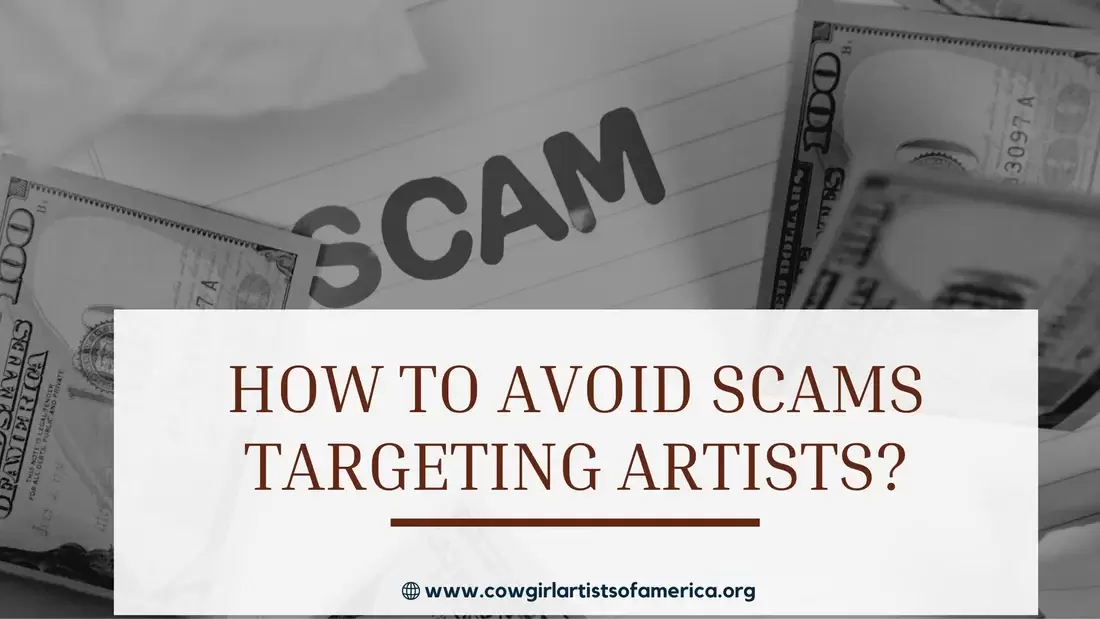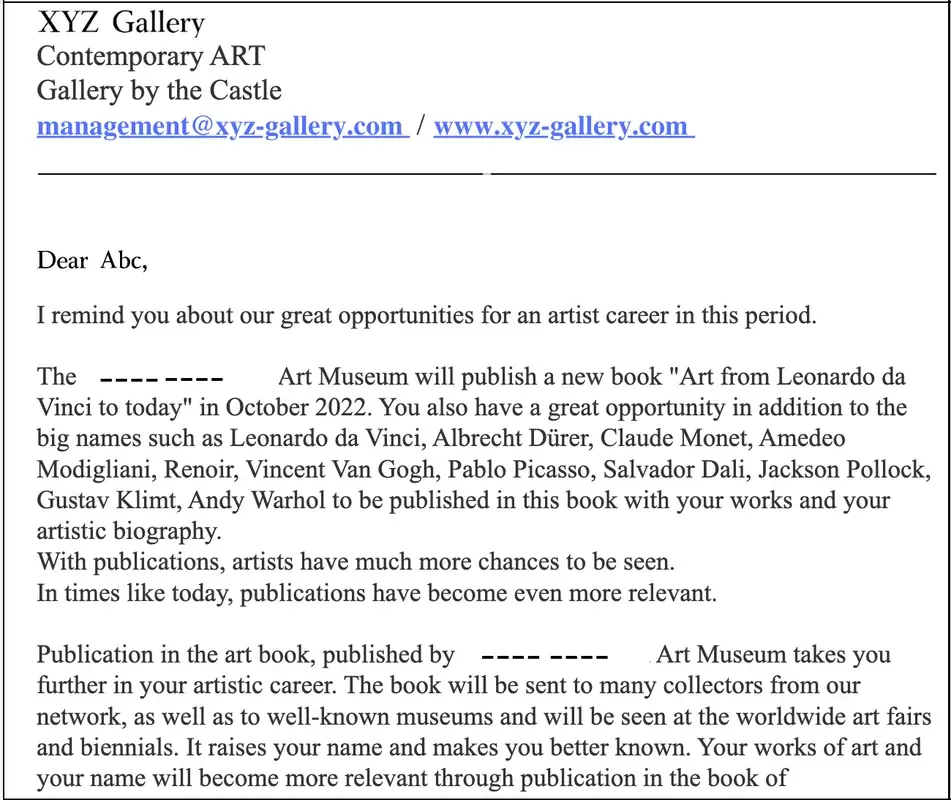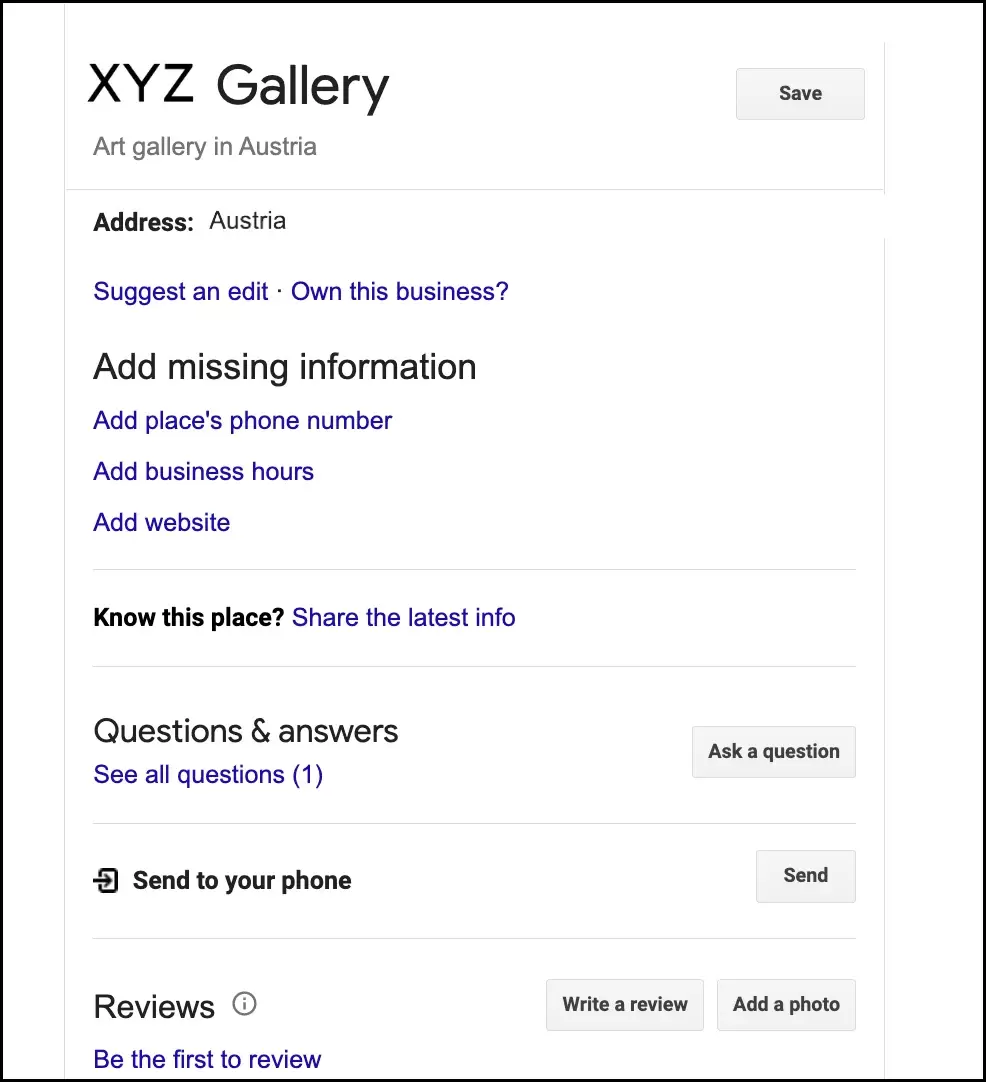Introduction
Like any other industry, the art business is also affected by scammers, and there are many scams targeting artists. As an artist, you must be aware of those scams and know how to recognize and stop them, so that you don’t lose your hard-earned money or artwork. Art Scams may occur through email, social media, job sites, and other websites. In this blog, we discuss some of the scams targeting artists and tips to recognize and stop art scams.
Types of Scams Targeting artistsOverpayment ScamsThis is the most common scam that every artist comes across. In this scam, you may receive an email from a person who says his wife loved your artwork and he wants to purchase your art immediately by paying the amount through a check or money order and gift his wife for her birthday. He may say that he has made an extra payment and ask you to send that money back. After a few days, the check bounces. As a result, you lose your valuable artwork and also your hard-earned money. Unpaid Internship or Hiring ScamsThis is a common scam, where “employers” post their unpaid job requirements on job portals, social media, newspapers, and even on tv or radio. They post their needs as legitimate employers and require you to create or provide previous artwork free of cost. They utilize your art and say you will get exposure. Sometimes scammers may ask you to create a design or artwork just for test purposes. Once you submit your artwork they reply by saying that they will let you know if you are shortlisted. However, they may go on to use your work without notifying or compensating you. *A note on internships and donations: While some internships and exposure opportunities can be valid, especially for causes you support, it is important that you know your business and the direction you want to go with your business to ensure that you don’t get taken advantage of. When you are first getting started or studying art in school, internship opportunities may be good for you to learn skills, gain connections, and sometimes add to your CV. Once you are running your business you need to be very particular about offering your work and time for free or at a reduced price. In some instances, like charity events and causes you are passionate about, it can make sense to donate work or time to support a good cause and gain connections. But remember “exposure” doesn’t pay your bills. Take time to consider all aspects of the “opportunity,” your business plans, and your goals for the year, to decide if it is a good fit for you. Social Media ScamSome people create fake social media accounts and comment or DM artists messages like, “If you are an artist you can be featured on our social media and get exposure. DM @___” If you contact them, they will reply that to be featured you need to pay some amount. Their interest is not in helping artists, but in collecting fees from them. These accounts are not targeted to a specific type of art and therefore not a good way to reach your target audience. Sometimes social media scammers may hack your account or take all your content and create duplicate fake profiles. The main goal of this scam is to get information like passwords or to try and get money from your followers and friends. According to Facebook’s 2022 data, there are 1.6 billion fake accounts. Gallery and Art Fair ScamIn a Gallery scam, the scammer will contact an artist and offer to represent them in their gallery, selling their artwork for a commission. These types of galleries overblow their reputation and charge artists to exhibit work. They make most of their money on artists’ fees, often exhibiting lower-quality work. Showing in a gallery like this will not build your reputation, and the gallery is unlikely to sell your work. These types of galleries have not built up a clientele interested in purchasing high-quality art, and since they aren’t particular about what they exhibit, they don’t have a reputation that brings in collectors. Another scam is for new online art galleries, selling platforms, or an art fair to send a message through social media or email like “New XYZ art gallery is opening soon, please register for the show by paying $_ _. If you pay them after a few days they may disappear. If you ask them, they may send a message like an event/gallery expo has been cancelled. This is shocking, yet, this is also a way scammers fool unaware or desperate artists. Here’s an example of an art gallery scam.
Image 1.1
Image 1.2
NOTE: In the above images, the names of the gallery and artist have been changed to protect personal information. Any resemblance to a real gallery is just a coincidence.
In Image 1.1 you can see the spamming nature of this gallery. Image 2.2. shows the scammer trying to get the artist to pay a fee to have their work published in a book. The importance of the gallery and the book is overblown. Also, note that the nature of the book is totally unrelated to the western artist who received this email.
Phishing scams
In this type of scam, the attacker or scammers may send text or email messages to steal your confidential information. They may try to get personal information like a contact number, address, account passwords, and bank account details by tricking you to click a link or downloading an attachment. Scammers may send an email or text message by using reputed company names or bank names. NEVER click on a suspicious link. They may use your credentials and steal your artwork. Companies like Facebook, will not contact you in this way.
Here is the example:
How to recognize & stop art scams?
Art scams are usually easy to recognize. Here are some of the clues for recognizing art scams.
Unregistered CompanyYou may be in a hurry to get into a gallery, get exposure, and sell your work. Scammers try to take advantage of this desperation, knowing that desperate people ignore red flags. They post fake opportunities with fake company names and without any contact information. Always do research on the company and its location before accepting an opportunity. If the company is legitimate it should have:
Fake Name & Email AddressScammers will not use their real names instead they use very suspicious names and email addresses. If an email address has an unusual name, uses a name similar to another organization, or lacks a domain-based name, it is a strong indication of a scam. Always check the name and email address of the person who is trying to scam you. Typically with organizations, you can search an email address and more information about that organization or person will come up. Online ReputationIf a social media account doesn’t have many followers, or if it has thousands of followers, but very little engagement, it could be a sign that this account is not to be trusted. Grammatical Errors in the EmailYou may notice there might be too many grammatical errors in the email or any content sent by spammers. This is a major warning sign of a scam. However, there are cases where a legitimate email does grammatical errors. For example, if the sender is not a native English Speaker. But, you have to be very careful with emails like this. Often you can copy the email or portions of the email and search in google. This may show you if it is associated with a common scam. If it doesn’t show up it could still be a scam. Pay attention to the contents of the email as well. Does it seem odd, or unnatural (too much background information, but otherwise overly general.) High Pressure and/or SpammingScammers often try to pressure you into an immediate decision or action. They may offer short answers, diminish your concerns, and say that you have limited time to respond. They may also spam your account by sending tons of emails or using fake social media accounts to comment on your content and then direct you to the main account. This is a way the main account avoids spam complaints to Instagram. Unrelated or Lacking Knowledge of Your WorkScammers often use general terms when referring to your art, this allows them to send the same message over and over to a variety of artists no matter what type of artist they are. The opportunities scammers are promoting may be oddly unrelated to your work. In the example email above the book the scammer was trying to get the artist to pay to be in, was Leonardo da Vinci, but the artist is a contemporary western artist. Finally, a scammer will say things that make you think they haven’t even looked at your work (that’s because they really haven’t). Vanity Art gallery or Art FairsDid you get an invitation to show your works in any Art galleries or art fairs that do not have a physical address? If you receive such an invitation, always check for a physical address. If they do not mention the location of the exhibition that is a red flag. Do a quick google search to see if the gallery has a website and location. If it exists see if it has any reviews, both on google and social media accounts.
Image 1.3
NOTE: In the above image, the name of the gallery has been changed to protect personal information. Any resemblance to a real gallery is just a coincidence.
In Image 1.1 & image 1.2, we have shown emails from a scammer Gallery and in Image 1.3 we can see that there are no reviews for the Gallery in Google. That shows the gallery is not popular and trying to profit off of unsuspecting artists.
Check Payment/Money orderIf the customer or art-selling platform sends a payment through check/money order, it is a sign of a scam. It is good practice to never ever accept check payments from any customer. If you do accept checks, wait for the payment to clear before providing any artwork. It is better to accept Paypal, Venmo, square, or other forms of payment processing. Fake Social Media AccountsConstantly monitor social media platforms for any attempts of impersonation by creating a fake social media account. Always verify your business profile, it helps you to grow your art business in an organic way. Include social media links on your website. So that customers can easily navigate to your social media accounts. Trust Your GutYour intuition is a great resource. If something seems off, even if you can’t quite place why it is a good idea to slow down and do a little research or even ask for advice. Scammers are finding more and more ways to try and take advantage of people. They typically prey on desperate people because they know that desperate people ignore red flags, and don’t take their time to do research. If something seems “off” or “too good to be true” it most likely is. Proceed with caution. Protect YourselfOne of the best things you can do is set up solid and reliable systems for accepting orders and commissions and taking payments. Take time to set your policies, and then refer back to them when you feel something might not be right. If someone is not respectful of your policies or tries to force you into something that feels uncomfortable to you that is a major red flag. Have you undergone any scams? Do share your experience and ideas to stop art scams in the comments below.
4 Comments
12/29/2022 11:51:03 am
Art Scams may occur through email, social media, job sites, and other websites. In this blog, we discuss some of the scams targeting artists and tips to recognize and stop art scams. Thank you, amazing post!
Reply
2/16/2023 03:07:12 am
That is really cute! You inspire me to continue posting! your benefits-focused blog. I appreciated the advice in this post to pick a painting that is the appropriate size for you.
Reply
3/16/2023 06:07:43 am
This article offers helpful tips for musicians and other creatives to avoid falling victim to online scamming. The article's author outlines the methods commonly employed by con artists to defraud creative types, such as phoney deals and contests, and provides advice on how to recognise and avoid them. This post is well-researched and full of useful information that can help artists safeguard their work and their careers.
Reply
4/25/2023 04:21:22 am
Scammers are a problem in any industry, and the art world is no exception. Many cons specifically target the creative community. By providing this article, you have greatly reduced my workload; also, I greatly admire your writing style. Keep writing, I really enjoy reading your posts. Come across Joshuacreekarts.com and hope you can visit this too to get more information.
Reply
Leave a Reply. |
Archives
March 2024
Categories
All
|





 RSS Feed
RSS Feed